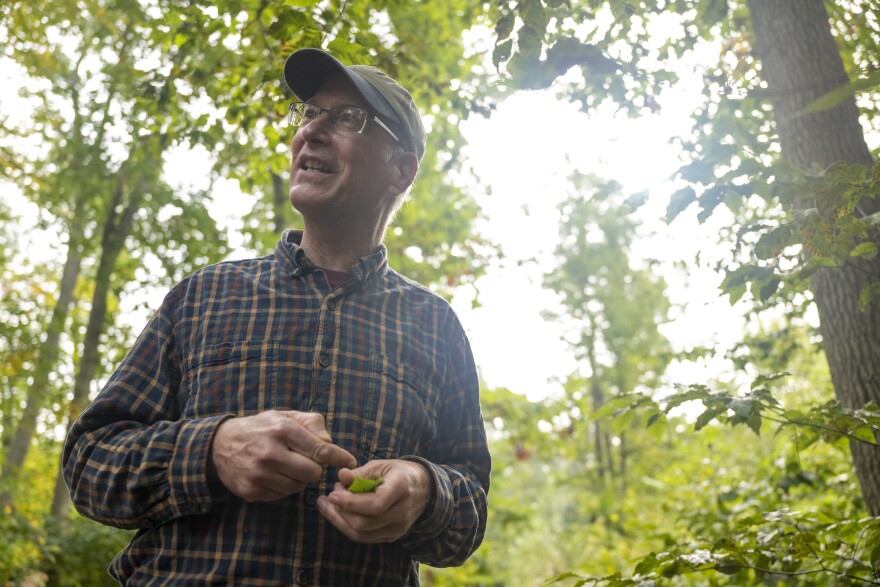In a small forest in Windsor, Connecticut, scientist Richard Cowles is among a team of Connecticut Agricultural Experiment Station employees spending his days studying a microscopic roundworm causing beech leaf disease.
The organism, a foliar nematode called litylenchus crenatae mccannii, feeds on the tree’s leaves and buds, causing premature leaf drop and weakening the tree so it is more susceptible to other pests and environmental stressors. In recent years, scientists said the invasive species dampened New England’s golden fall foliage because it caused unprecedented leaf drop.
Now, Cowles is trying to determine how such a tiny organism, which was first detected in Ohio in 2012, was able to rapidly spread to all of New England in less than 15 years.
“It’s unknown how the disease spreads and there is no cure,” officials told The Associated Press when the invasive worm was detected in Vermont for the first time last year.
But Cowles’s research team might change that.
Tracing the worms from tiny water droplets, to beech leaves
Cowles said his research revealed the invasive organism “can be blown in little aerosolized droplets during a heavy rain event when it's very windy.”
The distribution map for Beech leaf disease also suggests wind was playing a key role, according to Cowles.
“You can see the progress over time,” he said. “ “You'll notice that there's a very strong pattern moving eastward quickly and then up the coast quickly, which are also the prevailing directions for the wind.”
It’s not just wind that’s likely helping the organism spread, he said.
“This year, we have some evidence that they are also carried on the feet of birds during these rain events,” Cowles said.
He said they have also learned that the migration of the tiny worm between trees can begin as early as mid-July, several weeks earlier than previously thought, and it lasts well into the fall.
“We're talking about dozens of nematodes in every cell between the veins of the leaf,” Cowles said. “So there are literally millions or billions of nematodes that might be emerging from the leaves.”

Shriveled leaves, reduced resilience
An infected beech will develop dark bands on its leaves or the leaves will become crinkled, small and leathery.
It’s believed this invasive pest likely came from Asia, according to Cowles.
“Scientists have looked at the genetic sequence for the nematode here in North America and the one in Japan,” Cowles said. “They're nearly identical.”
Connecticut's beech trees have been in a steep decline and their growth has completely stagnated since the roundworm reached the state five years ago, according to state scientists.
“They may be barely managing to fulfill their metabolic demands,” CAES assistant agricultural scientist Elisabeth Ward said.
Emaciated trees would mean bad news for wildlife, Ward said, since they rely on the beech tree nuts as a food source.
Scientists say its full environmental impact has not yet been felt in New England.
“Bear in mind that we have had only a few years to document this disease,” state forest pathologist Robert Marra said. “Which is merely a blink in time when it comes to trees.”
Testing solutions to save beech trees
The research at CAES isn’t just focused on how the foliar nematode migrates from state to state, but also on how it can be combated.
Cowles said that while potassium phosphite is a good treatment to protect beech leaves from the roundworm, it's not economically possible to treat every beech in the state.
So he's testing two common compounds which can produce similar protective properties in plants.
"Some of these are aspirin and methyl salicylate, which is wintergreen flavoring," he said. “I'm applying these different products to beech saplings to see if we'll get a reduction in the number of leaves that show symptoms of infection by beach leaf disease.”
Another CAES ongoing study involves testing European varieties of beech to hopefully find a variety that can withstand the roundworm’s negative impact.
“There appears to be considerable genetic variation among European beech with respect to susceptibility to beech leaf disease,” Cowles said.
The European trees might also be a good alternative to one day replace the nut production lost by the American beech.
Cowles notes that New England wildlife, like squirrels and birds, “go crazy over the nuts from European Beech, just as they do on American Beech.”
This story includes reporting by The Associated Press. This story has been updated to show that potassium phosphite, not potassium phosphate, is used to protect beech leaves.





